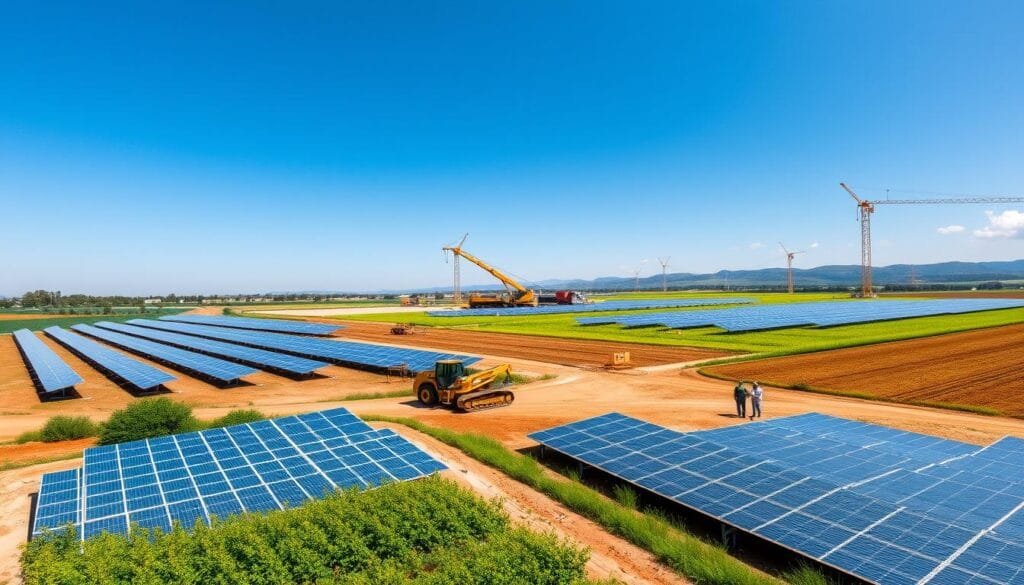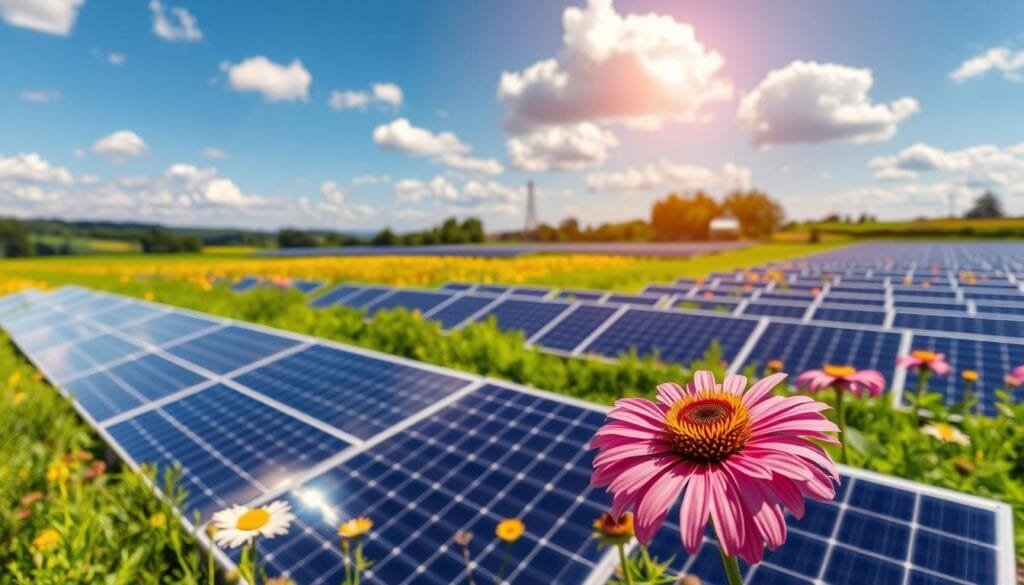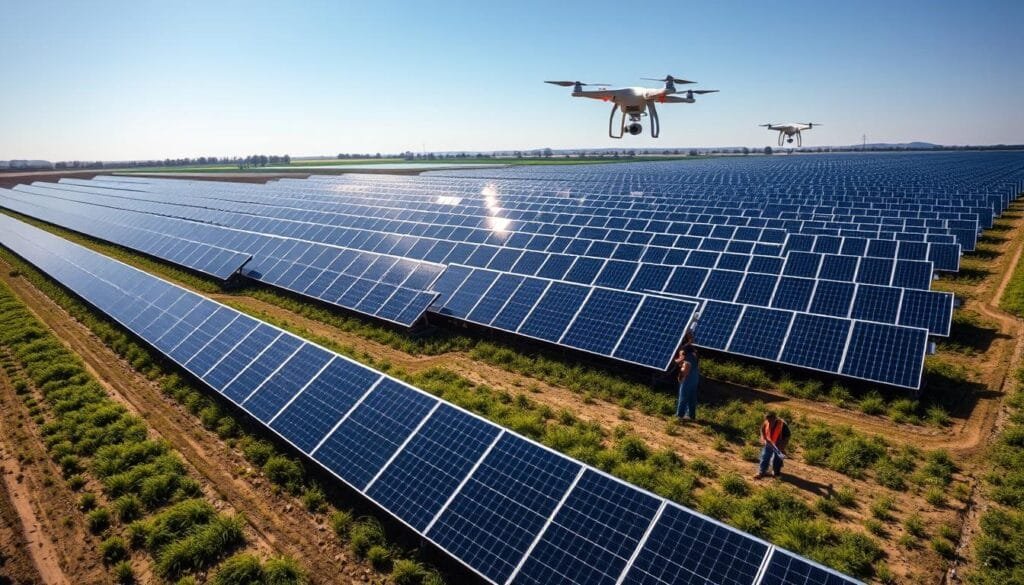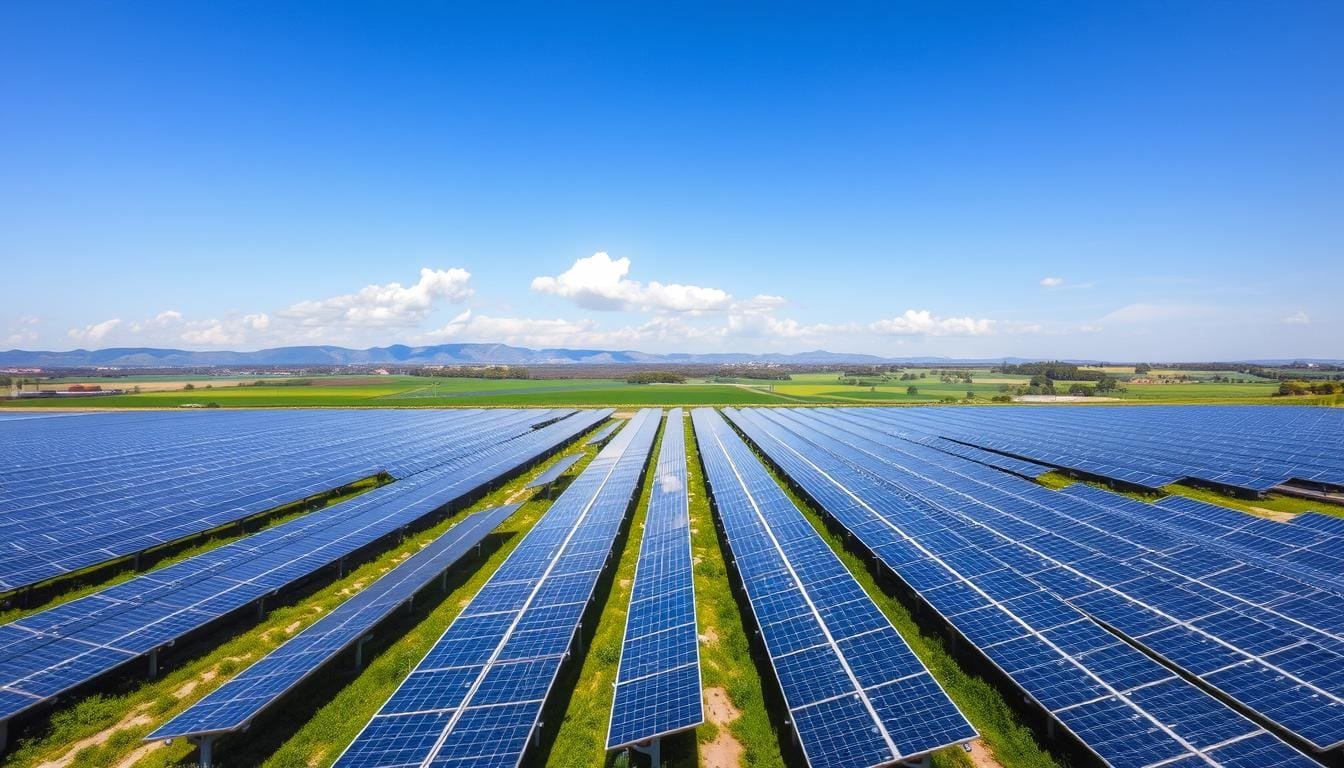Did you know solar energy in the United States has grown by 49% each year for the last decade? A solar farm is a big step toward using renewable energy. It turns sunlight into electricity on a huge scale.
A solar farm is a big place with hundreds or thousands of solar panels. These panels are spread out over large areas. They make electricity from sunlight and send it to homes and businesses through power grids.
The Oberon solar project in West Texas shows what solar farms can do. It has 180 megawatts of power and can light up about 30,000 homes a year. Projects like this are key to moving to cleaner energy.
Solar farms use new technology to make electricity from sunlight. They change sunlight into direct current electricity and then into alternating current for use at home and in businesses. These places help cut down on carbon emissions and support clean energy.
Key Takeaways
- Solar farms generate large-scale electricity using photovoltaic panels
- They can power thousands of homes through renewable energy
- Solar energy growth continues to accelerate in the United States
- Utility-scale solar farms contribute significantly to clean energy production
- Advanced technologies enable efficient solar energy conversion
What is a Solar Farm
Solar farms are a new way to make clean energy. They turn sunlight into electricity using special panels. These big setups cover lots of land, making clean energy for many people.
A solar power plant is more than panels. It’s a complex system that uses the sun’s power well. The tech keeps getting better, making solar farms more efficient and easy to use.
Basic Components of a Solar Farm
- Solar panel array: Hundreds to thousands of photovoltaic panels
- Mounting systems: Fixed or tracking ground installations
- Inverters: Convert DC electricity to AC for grid use
- Transformers: Adjust voltage for transmission
- Monitoring systems: Track energy production and performance
How Solar Farms Generate Electricity
Making electricity in a solar farm is simple. Panels catch sunlight, making electrons move and creating current. This current is then changed to fit the power grid.
| Solar Farm Type | Typical Capacity | Land Requirement |
|---|---|---|
| Utility-Scale | 1-2,245 MW | 200+ acres |
| Community Solar | 5-20 MW | 10-50 acres |
Types of Solar Farm Installations
- Utility-Scale Solar Farms: Large installations selling electricity directly to utilities
- Community Solar Gardens: Smaller projects serving local energy needs
- Floating Solar Farms: Innovative installations on water bodies
- Agrivoltaic Systems: Combining solar energy with agricultural production
“Solar farms are not just energy producers; they’re a testament to human innovation in sustainable technology.” – Clean Energy Research Institute
The Evolution of Solar Farming in America
The United States has seen a big change in solar energy over the years. What was once a small part of renewable energy has grown a lot. Solar farming has become a big player in our energy mix.
Looking at the history of solar farms shows how far we’ve come:
- 1982: First solar park generating 1 MW of electricity
- 2010: Rapid expansion of utility-scale solar projects
- 2024: Over 560 identified agrivoltaics and ecovoltaics sites
“Solar energy represents the most promising renewable energy source for sustainable power generation in America.” – Clean Energy Research Institute
The solar industry has grown fast. Today, we see the big impact of solar energy:
| Solar Capacity Metric | Current Status |
|---|---|
| Utility-Scale Solar Projects | 37,000 MW Operating |
| Total Solar Installations | 2.9 Million Across U.S. |
| Solar Workforce | Over 230,000 Professionals |
Technology has made solar cells much better. The first solar cell in 1954 only turned 4% of sunlight into energy. Now, we have cells that can turn 15-20% of sunlight into electricity.
The future of solar farming is exciting. With new ideas and more people using solar, it’s becoming a key part of our energy.
How Solar Farms Power Communities
Solar energy has changed how we get electricity. Solar farms use a new way to make power that’s good for the planet. They help meet local energy needs and cut down on pollution.
Community solar farms are a new way to share electricity. They make a lot of power for homes and businesses in the area.
Grid Connection and Distribution
Solar farms connect to the grid with special systems. This lets power flow easily. Here are some interesting facts:
- One megawatt of solar power can light up about 173 homes.
- Community solar projects work in 44 states.
- 24 states support community solar with laws.
Energy Storage Solutions
Storing energy is key for solar power’s ups and downs. New battery tech keeps the power on when it’s not sunny.
Power Output Capacity
| Solar Power Metric | Annual Performance |
|---|---|
| Total Solar Electricity Generated | 165 billion kilowatt-hours |
| Percentage of U.S. Electricity Supply | 3.9% |
| Homes Powered by Solar in California | 11 million |
“Community solar programs are changing how we think about energy.” – Clean Energy Expert
The future of solar energy is bright. New tech and more people joining in will keep making green energy better.
Utility-Scale Solar Farms Explained
Utility-scale solar farms are a new way to make renewable energy. They turn big areas into huge power makers. These farms can power thousands of homes and businesses.
These solar farms are really big. They can make from 1 to 50 megawatts of power. The biggest one in the US is in California’s Mojave Desert. It’s huge, covering 4,660 acres with over 1.9 million solar panels.
“Utility-scale solar farms are transforming our energy landscape, providing clean, sustainable power at an unprecedented scale.”
- Installations typically cover 4-6 acres per megawatt
- Most farms use solar tracking technology
- Operational lifespan of 20-30 years
Investing in utility-scale solar is smart. Costs range from $0.77 to $0.89 per watt. With tax credits, it can be even cheaper. The cost of the power is around $24 per megawatt-hour, which is getting close to traditional energy prices.
| Solar Farm Characteristic | Typical Range |
|---|---|
| Power Generation Capacity | 1-50 Megawatts |
| Installation Cost per Watt | $0.77-$0.89 |
| Wholesale Power Cost | $24 per MWh |
| Operational Lifespan | 20-30 Years |
By 2021, over 10,000 utility-scale solar farms were in the US. This is a big step towards using more sustainable energy. These farms make clean electricity and help reduce carbon emissions, making our environment better.
Community Solar Gardens: A Local Approach
Community solar gardens are a new way to share solar energy. They let local people join in, even if they can’t have solar panels on their roofs.
The world of solar energy is changing fast. Community solar is a big step towards using more renewable energy. Almost 50% of households and businesses can’t get solar panels on their own.
Benefits for Local Residents
Community solar gardens bring many good things to local areas:
- Lower electricity bills thanks to solar power
- No need for solar panels on your roof
- More control over your energy use
- Helping to build a green energy future
Virtual Net Metering Systems
Virtual net metering lets people get credits for solar energy. This way, they can enjoy solar power without owning panels.
| State | Community Solar Capacity | Policy Support |
|---|---|---|
| Florida | 2,085 MW-AC | Strong |
| New York | 1,764 MW-AC | Comprehensive |
| Massachusetts | 1,014 MW-AC | Supportive |
| Minnesota | 910 MW-AC | Encouraging |
Community solar turns renewable energy into a shared community asset.
Now, community solar gardens are in 44 states. They’re making clean energy more available to many people.
Solar Farm Construction Process

Building a solar power plant is a complex task. It turns empty land into a place that makes electricity. This process needs careful planning, a lot of money, and precise work.
Developers go through many important steps when building a solar farm:
- Initial site feasibility assessment
- Comprehensive environmental impact studies
- Securing necessary permits and approvals
- Procurement of solar equipment
- Ground preparation and infrastructure setup
Building a solar farm costs a lot of money. About 80% of the money comes from bank loans. The rest comes from investors. Developers must do detailed financial checks to make sure the project will make money.
“Solar farm construction is not just about installing panels, but creating a sustainable energy ecosystem.” – Energy Infrastructure Expert
The part where you buy the equipment can take a few months to a whole year. Important things to think about include:
- Evaluating solar radiation levels
- Assessing grid connectivity
- Designing structural frameworks
- Planning electrical system integration
Solar projects can be big, from 1 to 100 megawatts. On average, they are about 5 megawatts. They need about 5-7 acres of land for every megawatt, showing how much space is needed.
Building solar farms has gotten cheaper, with costs dropping over 75% in ten years. This makes solar farms more appealing to investors and communities looking for green energy.
Key Components of Solar Farm Infrastructure
Solar farms are complex systems that turn sunlight into electricity. They have many parts working together. This makes them efficient at generating power.
Photovoltaic Panels: The Energy Conversion Core
The heart of a solar farm is the solar panel array. These panels use special cells made from silicon. When sunlight hits these cells, they create electricity.
- They can turn light into electrical energy.
- They are mostly made of silicon, silver, and aluminum.
- Some panels can even make electricity from both sides.
Inverters and Transformers: Power Conversion Specialists
The system needs special parts to make solar energy useful. Inverters change direct current (DC) to alternating current (AC). Transformers adjust the voltage so it fits the grid.
“Each solar farm transforms raw solar energy into grid-ready electricity through precision engineering.” – Solar Energy Experts
Mounting Systems: Structural Support Framework
Mounting systems are key for holding panels in place and getting them to face the sun right. They are made for:
- Getting the most sunlight
- Keeping panels stable
- Making it easy to put up and fix them
Today’s systems use aluminum frames. They are strong, easy to set up, and good for the environment.
Environmental Impact and Sustainability
Solar farms are a key part of green energy production. They offer big environmental benefits but also face sustainability challenges. Solar technology is a clean way to make electricity, unlike fossil fuels.

The effects of solar farms are complex. They have both good and bad sides:
- They cut down greenhouse gas emissions
- They use very little water to make electricity
- They might affect land use and habitats
- They raise long-term ecological questions
Big solar farms can cause big environmental problems. Utility-scale solar facilities, with a power output of 20 MW or more, can harm local ecosystems in several ways:
- They can compact the soil
- They can change how water drains
- They might disrupt wildlife habitats
“Solar energy development could need up to 5.7 million acres by 2035, which is about 0.3% of the contiguous United States.” – U.S. Department of Energy
| Environmental Aspect | Impact Assessment |
|---|---|
| Carbon Emissions | Significantly Reduced |
| Water Resource Usage | Low to Moderate |
| Land Transformation | Moderate Ecological Changes |
Research projects, like the InSPIRE project by the National Renewable Energy Laboratory, are working hard. They aim to make solar farms better fit with nature and farming.
Solar farms face environmental hurdles but are key in fighting climate change. They help us move towards sustainable energy. More research and new tech are needed to lessen harm to nature.
Solar Farm Investment and Costs
Investing in a solar power plant needs careful planning and understanding of the economy. Developers and investors face big upfront costs. They also look at the long-term earnings from solar farms.
Initial Setup Expenses
The cost to start a solar power plant varies a lot. A 1 MW solar farm can cost between $890,000 and $1.01 million. Key costs include:
- Equipment procurement
- Land acquisition
- Infrastructure development
- Permitting and regulatory compliance
Breakdown of Investment Costs
Investors need to think about these financial points:
| Cost Component | Average Expense |
|---|---|
| Solar Panel Installation | $0.98 per watt |
| Land Lease | $300-$4,000 per acre annually |
| Annual Revenue | $40,000-$43,500 |
Ongoing Maintenance Costs
Keeping a solar farm running costs money. Utility-scale solar farms need repairs three to four times a year. Annual upkeep includes:
- Panel cleaning and inspection
- Electrical system checks
- Infrastructure repairs
- Performance monitoring
“The solar business has experienced significant growth over the past decade, indicating strong market interest and expansion.” – Energy Industry Experts
Knowing these costs helps investors make smart choices about solar farms.
Maintenance and Operations
Solar farm maintenance is key to keeping solar power plants running well. The National Renewable Energy Laboratory (NREL) stresses the need for regular maintenance. It can greatly improve energy output and efficiency.

- Regular panel cleaning and inspection
- Performance monitoring systems
- Electrical system checks
- Equipment diagnostic procedures
“Preventive maintenance is the key to maximizing solar farm performance and extending equipment life.” – NREL Research
The maintenance cycle covers many activities to keep systems reliable. Experts suggest a detailed plan for solar farm upkeep:
| Maintenance Activity | Frequency | Purpose |
|---|---|---|
| Panel Cleaning | Every 2-4 weeks | Remove dust and debris to maintain efficiency |
| Electrical System Inspection | Quarterly | Check inverters, connections, and performance |
| Comprehensive System Audit | Annually | Detailed assessment of overall system health |
Studies show that proper maintenance can stop big energy losses. Dirty solar panels can lose up to 50% of their output in six months. New monitoring tools let operators spot and fix problems fast.
Managing water is also vital in solar farm upkeep. Cleaning panels might need 3-8 liters of water per panel. In dry areas, panels need more frequent cleaning to keep energy production high.
Permits and Regulations for Solar Farms
Getting through the maze of permits and rules is key for building solar farms. The rules come from many government groups and need careful planning and following.
Developers of solar farms must get many permits from different groups. Getting these permits can be hard and changes a lot depending on where you are.
- Local government land-use permits
- Environmental impact assessments
- Electrical grid interconnection approvals
- State-level renewable energy certifications
“Regulatory compliance is not just a legal requirement, but a critical component of sustainable solar power plant development.” – Renewable Energy Institute
Important rules for solar farms include protecting the environment, following land use rules, and meeting grid standards. Developers must show they won’t harm nature and follow local zoning laws.
| Permit Type | Typical Processing Time | Key Requirements |
|---|---|---|
| Land Use Permit | 3-6 months | Zoning compliance, environmental impact |
| Environmental Permit | 4-8 months | Ecological assessment, mitigation plans |
| Grid Interconnection | 2-4 months | Technical grid compatibility review |
Regulatory landscapes differ dramatically across states. New York, for instance, caps solar farms at 5 MW, while states like California and Texas offer more flexibility for larger solar power plant installations.
Successful solar farm developers spend a lot of time learning local rules, talking to the community, and keeping open lines with government agencies.
Location Requirements and Site Selection
Finding the right spot is key for a solar farm’s success. It’s about looking at many important factors. These factors affect how well the solar farm works and lasts over time.
Solar Resource Assessment
Developers need to check the sun’s power at a site. They look at:
- How much sunlight the area gets each year
- The weather patterns
- How much sun hits the area in different seasons
Land Requirements and Considerations
The land’s features are very important for building a solar farm. Experts say certain things about the land are best:
| Solar Farm Type | Land Requirement | Optimal Slope |
|---|---|---|
| Distribution-Scale | 10-50 acres | Less than 5 degrees |
| Transmission-Scale | 200+ acres | Less than 5 degrees |
Grid Connectivity Considerations
Being close to power lines is very important. The best sites are:
- Within 3 miles of substations
- Near power networks
- Ready to handle the energy output
“Strategic site selection can reduce solar farm construction costs by up to 30%.” – Renewable Energy Experts
Developers also have to think about rules, local laws, and what the community thinks. This helps the project go smoothly.
Conclusion
Solar farms are changing how we make electricity, leading to a cleaner future. Over 5,000 solar farms in the U.S. now power nearly 3.4% of our homes. They are key to our green energy future.
Solar farms are good for the economy and the planet. They can make over 300,000 kWh of electricity per acre each year. This shows how efficient they are. With sizes from 1 MW to 2,000 MW, they are flexible and promising.
As technology gets better, solar farms will become even more important. They are making electricity cleaner and cheaper. This is a big step towards a sustainable energy future.
By using solar farms, we can make our energy system better. This is not just good for the planet. It’s also a chance for new tech and jobs in the green energy field.
FAQ
What exactly is a solar farm?
How do solar farms generate electricity?
What are the different types of solar farms?
How much land is required for a solar farm?
Are solar farms environmentally friendly?
What is the typical lifespan of a solar farm?
How do solar farms connect to the electrical grid?
What are the main challenges in developing a solar farm?
How much does it cost to build a solar farm?
FAQ
What exactly is a solar farm?
A solar farm is a big solar power setup. It uses many photovoltaic panels to make electricity on a big scale. Unlike home solar systems, solar farms cover lots of land. They make electricity for the grid, powering thousands of homes and businesses.
How do solar farms generate electricity?
Solar farms make electricity by turning sunlight into electrical energy. Sunlight hits the solar panels, exciting electrons. This creates an electric current. The current is then changed to alternating current (AC) by inverters, ready for the grid.
What are the different types of solar farms?
There are two main types of solar farms. Utility-scale solar farms are huge, making lots of electricity for the grid. Community solar gardens are smaller. They let local people share solar energy without panels on their own homes.
How much land is required for a solar farm?
The land needed for a solar farm depends on its size. Utility-scale farms need 5 to 10 acres for 1 megawatt of electricity. Big commercial farms can cover hundreds of acres, powering thousands of homes.
Are solar farms environmentally friendly?
Solar farms are clean and good for the environment. They don’t make greenhouse gases and help fight climate change. But, they use land and solar panels have a manufacturing impact, which needs careful management.
What is the typical lifespan of a solar farm?
Solar farms usually last 25-30 years. Solar panels keep about 80-85% efficiency after 25 years. Regular care and new tech can make them last longer and work better.
How do solar farms connect to the electrical grid?
Solar farms link to the grid through substations and lines. Inverters change the direct current (DC) from panels to alternating current (AC). Transformers adjust the voltage for smooth grid use.
What are the main challenges in developing a solar farm?
Developing a solar farm faces many challenges. Securing land, getting permits, and managing costs are big ones. Ensuring grid connection, following local rules, and addressing environmental issues are also key. Choosing the right site and engaging with the community are critical.
How much does it cost to build a solar farm?
The cost to build a solar farm varies a lot. It depends on size, location, and tech used. Costs include land, panels, mounts, inverters, and grid connection. A 1-megawatt project can cost from
FAQ
What exactly is a solar farm?
A solar farm is a big solar power setup. It uses many photovoltaic panels to make electricity on a big scale. Unlike home solar systems, solar farms cover lots of land. They make electricity for the grid, powering thousands of homes and businesses.
How do solar farms generate electricity?
Solar farms make electricity by turning sunlight into electrical energy. Sunlight hits the solar panels, exciting electrons. This creates an electric current. The current is then changed to alternating current (AC) by inverters, ready for the grid.
What are the different types of solar farms?
There are two main types of solar farms. Utility-scale solar farms are huge, making lots of electricity for the grid. Community solar gardens are smaller. They let local people share solar energy without panels on their own homes.
How much land is required for a solar farm?
The land needed for a solar farm depends on its size. Utility-scale farms need 5 to 10 acres for 1 megawatt of electricity. Big commercial farms can cover hundreds of acres, powering thousands of homes.
Are solar farms environmentally friendly?
Solar farms are clean and good for the environment. They don’t make greenhouse gases and help fight climate change. But, they use land and solar panels have a manufacturing impact, which needs careful management.
What is the typical lifespan of a solar farm?
Solar farms usually last 25-30 years. Solar panels keep about 80-85% efficiency after 25 years. Regular care and new tech can make them last longer and work better.
How do solar farms connect to the electrical grid?
Solar farms link to the grid through substations and lines. Inverters change the direct current (DC) from panels to alternating current (AC). Transformers adjust the voltage for smooth grid use.
What are the main challenges in developing a solar farm?
Developing a solar farm faces many challenges. Securing land, getting permits, and managing costs are big ones. Ensuring grid connection, following local rules, and addressing environmental issues are also key. Choosing the right site and engaging with the community are critical.
How much does it cost to build a solar farm?
The cost to build a solar farm varies a lot. It depends on size, location, and tech used. Costs include land, panels, mounts, inverters, and grid connection. A 1-megawatt project can cost from $1 million to $2.5 million.
Can solar farms work in areas with less sunlight?
Yes, solar farms can work in areas with less sunlight. New tech in panels and tracking systems help. But, how much energy they make depends on local sunlight.
million to .5 million.
Can solar farms work in areas with less sunlight?
Yes, solar farms can work in areas with less sunlight. New tech in panels and tracking systems help. But, how much energy they make depends on local sunlight.

